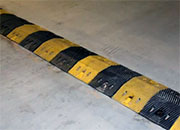
TUESDAY, Dec. 18 (HealthDay News) — Speed bumps are great for slowing down heavy-footed motorists, but they might speed up the diagnosis of acute appendicitis, a new study says.
Although there is no specific clinical diagnostic test for appendicitis, researchers in Great Britain found that if patients’ abdominal pain got worse while driving over speed bumps, they were more likely to have the condition.
“It may sound odd, but asking patients whether their pain worsened going over speed bumps on their way in to [the] hospital could help doctors in a diagnosis,” Dr. Helen Ashdown, of the department of primary care health sciences at the University of Oxford, said in a news release. “It turns out to be as good as many other ways of assessing people with suspected appendicitis.”
The results of the study were published online Dec. 17 in the journal BMJ.
The study, conducted by researchers from the University of Oxford and Stoke Mandeville Hospital, involved more than 100 patients between 17 and 76 years old who went to the hospital for possible appendicitis.
The patients were divided into two groups within 24 hours of their arrival at the hospital: speed-bump positive or speed-bump negative.
The patients who were considered “positive” had abdominal pain that got worse when they drove over a speed bump. Patients whose pain got better or stayed the same traveling over a speed bump were put into the “negative” group. Those who could not tell how the speed bump affected their pain were also classified as “negative.”
The study found 64 patients drove over a speed bump on the way to the hospital. Of these, 84 percent were considered “speed-bump positive.”
The researchers also found that half of the patients who went over a speed bump had a confirmed diagnosis of acute appendicitis. Of these patients, 97 percent had pain that got worse when they hit the speed bump.
The researchers noted that seven of the patients who were in the “positive” group that did not have appendicitis were diagnosed with other serious conditions such as ruptured ovarian cyst or diverticulitis (bulging sacs or pouches typically found in the large intestine).
The study’s authors said the speed bump test works just as well as other methods used by doctors to diagnose appendicitis. They added, however, that being speed-bump positive doesn’t guarantee a diagnosis of appendicitis. Instead, the researchers concluded, the test should be a routine part of doctors’ assessment for the condition.
Doctors currently diagnose appendicitis by looking for symptoms, such as abdominal tenderness or swelling, during a physical examination. When obvious signs don’t exist, they also may order imaging tests.
More information
The U.S. National Digestive Diseases Information Clearinghouse provides more information on appendicitis.

